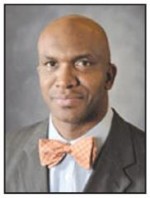Moffitt researcher inspired to heal, help

When he was 13, Dr. B. Lee Green knew he wanted to work in the medical field. After seeing his diabetic grandmother go to the hospital and return with no legs, Green felt an even deeper aspiration toward the profession.
“I just thought that maybe there was something that I could do to really help people in the community to not go through what she went through,” Green said.
Though he played basketball in college, Green did not let others sway him toward easy majors. He went on to graduate with his PhD from the University of Alabama and later became director of Texas A&M’s Center for the Study of Health Disparities.
Green now calls USF home. Here, Green is a professor of Health Outcomes and Behavior at the Moffitt Cancer Center.
In late 2007, Green was promoted to vice president of the Office of Institutional Diversity (OID) at Moffitt.
According to Green, the OID is responsible for making sure that patients seen at Moffitt reflect the diversity of the Tampa Bay area and that the physicians and medical staff mirror that diversity.
The OID also conducts research on health disparities between races in hopes of discovering the causes of these differences.
“Health disparities is a pretty simple concept,” Green said. “It really means that there are certain segments of our population that suffer disproportionately from disease and disorders compared to other populations.”
Dr. Deanna Wathington, director of the Public Health Practice program for the college of Public Health, finds the studies taking place at the OID useful.
“I certainly agree that there are disparities, and that’s been well documented in over 600 studies,” Wathington said. “Dr. Green’s office is adding to our arsenal of what we bring to improve the lives and health of patients.”
Wathington, who served as the first director of minority health for the state of Florida, said the efforts of the OID correlate with national programs, like Healthy People 2010, which aim to prolong the life of Americans and eliminate disparities.
“It’s a wonderful addition and it’s definitely needed,” Wathington said.
Green provided one example to illustrate how the OID might analyze a disparity.
According to Green, prostate cancer is much more prevalent among black men than white men.
“What is interesting about prostate cancer is that if you control for income, control for education, and control for when patients go in and get diagnosed, making everything equal, African American men’s likelihood of developing prostate cancer and even dying from the cancer tends to be double that of white men,” he said.
The OID tries to identify and understand these types of discrepancies between races.
“Our health as a country is getting better every single year and prevalence of disease is much lower,” said Green. “But what has not changed is the gap between populations.”
As vice president, Green plans to implement a more concrete way of conducting OID studies.
“Working on diversity can be distracting. Now we are focusing on eight initiatives.”
These initiatives include faculty diversity, staff diversity, health disparities research, minority participation in clinical trials, cultural competency, community relations, patient access, and race and ethnic data collection.
“Primarily, in terms of cultural competency, we want to make sure that the physicians that see patients are understanding of different races and ethnic backgrounds, as well as those of lower socioeconomic status,” Green said.
Because of his new appointment, Green said he will be able to get the OID’s mission into the community.
“It allows me the opportunity to sit next to the people who are running different aspects of the hospital, and I can really talk to them about diversity efforts,” Green explained. “The diversity office really cannot get anything done without collaborating with other people throughout the institution.”
Although the OID aims to promote diversity in the workforce, Green said that he does not believe in filling quotas.
“I believe that we go after the best possible person that we can find for a position,” he said.
Even with a qualified team and a welcoming environment for patients of all backgrounds, Green said that finding the true causes of disparities in diagnosis and treatment is still very complex.
He also said he hopes to provide models of which diversity efforts work and which do not.
“My ultimate goal would be to make a mark not only at this institution, but at other institutions across the country.”
Throughout all his efforts to study the disparities between races, Green has never forgotten his grandmother.
“It’s easy to forget that the people we’re talking about are real,” Green said. “When I am looking at data, my grandmother is a constant reminder that these are real people.”






